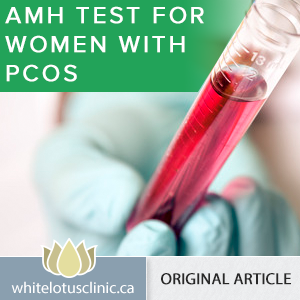AMH – An Important Hormone Test for Women with PCOS

AMH (Antimullerian Hormone) is a key hormone – it is secreted by the follicles which house the eggs in our ovaries. It’s thought that AMH levels correlate with the number of viable eggs remaining in a woman’s ovary. In women who suffer from a condition known as diminished ovarian reserve (DOR), this number can often be quite low, indicating that there are few remaining follicles within the ovary. What isn’t widely known, is that the testing of AMH can also be a useful test for women with PCOS, particularly in those who are struggling with receiving a diagnosis.
AMH is secreted mostly by the small antral follicles in the ovary that are between 5-8mm in size. In many women with PCOS, there is an increase in the number of this type of follicle – in essence, the follicles begin to develop and then stall before they are ovulated. Recent research also suggests that in addition to the increased number of antral follicles in the ovary of women with PCOS, there is also an increased production of AMH by the individual follicle cells.
Coincidentally, too much AMH may actually be a major culprit in stopping ovulation from happening. In a normal ovary, AMH works to slow and prevent the premature development of the follicles before they are mature – keeping the ovary from developing eggs prematurely. AMH works by reducing the ovary’s receptors to FSH, the main pituitary gland hormone that causes an egg to develop each cycle. When the AMH is much too high, as it is in PCOS you can imagine that this effect can go too far and the production of a healthy egg every cycle can be halted.
It’s not known exactly what causes the ovarian cells in PCOS to overproduce AMH however it’s thought that it may be related to increased levels of the pituitary hormone LH. Normally LH is released in a strong surge that triggers ovulation – but when it is too high for too long it can inhibit ovulation and cause the overproduction of testosterone. AMH levels also directly correlate to blood levels of testosterone, however it’s difficult to know whether this is cause or effect. It’s thought that perhaps there may even be an slight mutation in the AMH gene or AMH receptors in women with PCOS.
In clinic, I’ve seen many women who have gone undiagnosed with PCOS for years – running a simple AMH test and correlating the results with other aspects of the case has brought clarity to the cases of these many women who have struggled with undiagnosed hormonal problems throughout their lives. Fortunately, AMH is a simple blood test that can be done on any cycle day.
In women who don’t necessarily have the other obvious signs of PCOS, or who are lean, this one test can often help to differentiate the condition. It’s important to know that AMH levels decrease with age and as such you should correlate these results with your age. Another important thing to note is that there are two different units commonly used for measuring AMH – so please check carefully as to the unit your measurement was taken in.
The 3 Criteria to Diagnose PCOS are 2 of the 3 Following Symptoms
- Delayed Ovulation
- Polycystic Ovaries on Ultrasound (multiple small follicles)
- Clinical or Lab Markers – indicating increased androgens like hirsutism, adult acne and hair loss.
I’ve begun to use AMH as almost a replacement for the polycystic ovaries on ultrasound – since it reflects the ovary’s imbalance of hormones that causes ovulation to stall. In addition, I’ve found it’s quite rare to see polycystic ovaries on ultrasound in women over 35, and in women who ovulate who have PCOS – yet you can still often pick up elevated AMH levels in this group.
Typical age-related ranges for AMH are listed below. These are compiled from evidence and our own clinical experience at the clinic working with fertility patients and women with PCOS. This is a complex topic for which the scientific evidence still isn’t conclusive, so I’ve done my best to explain the important details to consider below the ranges. As mentioned previously, women with PCOS will tend to have AMH levels above the average range for their age bracket.
| Age | ng/ml | pmol/L |
|---|---|---|
| Under 33 years old | 2.1 - 6.8 | 15.0 - 48 |
| 33 - 37 years old | 1.7 - 3.5 | 12.14 - 32.13 |
| 38 - 40 years old | 1.1 - 3.0 | 7.8 - 21.42 |
| 41+ years old | 0.5 - 2.5 | 3.57 - 17.85 |
At any age, an AMH over 6.8 ng/ml (or 48 pmol/L) is considered high and potentially a sign of pcos. It’s important to note that the above top end ranges particularly for women over 35 are not exact, and are calculated from our experience in the clinic. These ranges are NOT hard cut offs, and each woman will be different depending on her whole hormonal picture. If you are above the top of the range for your age, this is suspicious of PCOS.. If you are far above the range – the chances of PCOS are MUCH increased. Important to note,the youngest range of under 33 comprises a very large age bracket – so for example if you are 32 and your AMH is 6.8, this may be much more significant than in a 20 year old with this number.
When it comes to very elevated levels, studies have determined that around 97% of women with an AMH over 10 ng/ml (71 pmol/L) have PCOS. Some other studies have even linked an AMH over 3.0 ng/ml (21.42 pmol/L) to be a factor suspicious of PCOS, particularly if found in conjunction with other symptomatology of the syndrome however I’ve also seen this level to be a normal finding in younger women without PCOS. Also, the higher the AMH, the more severe the PCOS symptoms may be, as its effects on the ovary are more profound.
If you are over 35 years old and your AMH is still very high – this is quite significant and it’s quite likely that you may have PCOS so please ask your doctor for more information or seek out a doctor who is familiar with PCOS – as this is one of the most underdiagnosed women’s health conditions. If your AMH is borderline high for your age, it’s possible you may have a slight hormonal leaning towards pcos, or possibly even just a good ovarian reserve so please dig deeper into causes with the help of your doctor.
Typical general ranges for AMH with respect to egg reserve and fertility are listed here – however please note that these are NOT age related. As described above AMH of 4.5 ng/ml may be a sign of PCOS in a 45 year old, however it is totally normal in a 25 year old.
| ng/ml | pmol/L | |
|---|---|---|
| Optimal fertility | 4.0 – 6.8 | 28.6 – 48.5 |
| Satisfactory fertility | 2.2 – 4.0 | 15.7 – 28.6 |
| Low fertility | 0.3 – 2.2 | 2.2 – 15.7 |
| Very low fertility | 0.0 – 0.3 | 0.0 – 2.2 |
| Likely PCOS | above 6.9 | above 48.5 |
Reference: Dr. Malpani – Malpani Infertility Clinic
References
- Gleicher et al. Center for Human Reproduction. AMH and FSH – Age Specific Baseline Ranges
- Bhide P, Dilgil M, Gudi A, Shah A, Akwaa C, Homburg R. Each small antral follicle in ovaries of women with polycystic ovary syndrome produces more antimüllerian hormone than its counterpart in a normal ovary: an observational cross-sectional study. Fertil Steril. 2015 Feb;103(2):537-41.
- Eilertsen TB, Vanky E, Carlsen SM. Anti-Mullerian hormone in the diagnosis of polycystic ovary syndrome: can morphologic description be replaced? Hum Reprod. 2012 Aug;27(8):2494-502.
- Yoo JH, Kim HO, Cha SW, et al. Age specific serum anti-Müllerian hormone levels in 1,298 Korean women with regular menstruation. Clinical and Experimental Reproductive Medicine. 2011;38(2):93-97.





